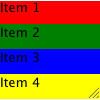Object List Model Example#
A list of QObject values can also be used as a model. A list[QObject,] provides the properties of the objects in the list as roles.
The following application creates a DataObject class with Property values that will be accessible as named roles when a list[DataObject,] is exposed to QML:

# Copyright (C) 2022 The Qt Company Ltd.
# SPDX-License-Identifier: LicenseRef-Qt-Commercial OR BSD-3-Clause
from pathlib import Path
import sys
from PySide6.QtCore import QObject, QUrl, Property, Signal
from PySide6.QtGui import QGuiApplication
from PySide6.QtQuick import QQuickView
# This example illustrates exposing a list of QObjects as a model in QML
class DataObject(QObject):
nameChanged = Signal()
colorChanged = Signal()
def __init__(self, name, color, parent=None):
super().__init__(parent)
self._name = name
self._color = color
def name(self):
return self._name
def setName(self, name):
if name != self._name:
self._name = name
nameChanged.emit()
def color(self):
return self._color
def setColor(self, color):
if color != self._color:
self._color = color
colorChanged.emit()
name = Property(str, name, setName, notify=nameChanged)
color = Property(str, color, setColor, notify=colorChanged)
if __name__ == '__main__':
app = QGuiApplication(sys.argv)
dataList = [DataObject("Item 1", "red"),
DataObject("Item 2", "green"),
DataObject("Item 3", "blue"),
DataObject("Item 4", "yellow")]
view = QQuickView()
view.setResizeMode(QQuickView.SizeRootObjectToView)
view.setInitialProperties({"model": dataList})
qml_file = Path(__file__).parent / "view.qml"
view.setSource(QUrl.fromLocalFile(qml_file))
view.show()
r = app.exec()
del view
sys.exit(r)
// Copyright (C) 2021 The Qt Company Ltd.
// SPDX-License-Identifier: LicenseRef-Qt-Commercial OR BSD-3-Clause
import QtQuick
ListView {
width: 100; height: 100
delegate: Rectangle {
color: model.modelData.color
height: 25
width: 100
Text { text: model.modelData.name }
}
}